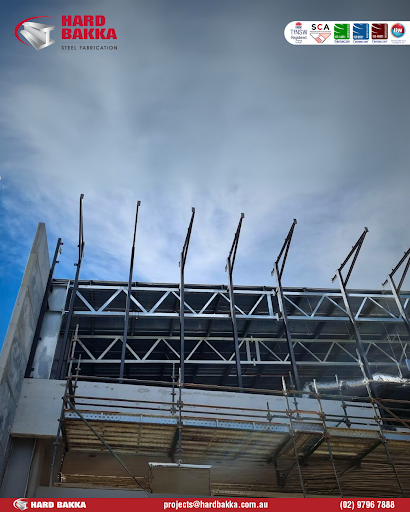Hard Bakka Latest News
Structural Steel Installation: Key Processes, Challenges, and Innovations
Steps in Structural Steel Installation
The structural steel installation process involves several important steps, ensuring that the steel framework is assembled accurately and securely. Here’s a detailed overview of the key stages:
- Fabrication: The process begins with the fabrication of steel components, where raw steel is cut, shaped, and welded into the required forms.
- Delivery: Fabricated steel parts are transported to the construction site, with careful planning to ensure that all materials arrive on time and in good condition.
- Assembly: The steel components are then assembled on-site, following the design specifications to ensure correct alignment and positioning.
- Final Inspection: Once the assembly is complete, a thorough inspection is conducted to verify that all connections are secure, and the structure meets safety and quality standards.
Welding and Bolting Techniques
Welding and bolting are used to connect steel components during installation. Here’s an overview of these techniques:
- Welding Methods:
- Shielded Metal Arc Welding: Commonly known as stick welding, this method is widely used for its versatility and strength.
- Gas Metal Arc Welding: Also known as MIG welding, this method is preferred for its speed and ease of use.
- Flux-Cored Arc Welding: Similar to MIG welding, but with a flux core that allows for welding in outdoor environments.
- Types of Bolts:
- High-Strength Bolts: Used for connections requiring maximum strength.
- Anchor Bolts: Embedded in concrete to secure steel columns and beams.
- Tension Control Bolts: Provide a precise and consistent clamping force, ideal for structural applications.
Ensuring Safety During Installation
Safety is paramount in structural steel installation, where workers often operate at significant heights and handle heavy materials. Key safety protocols and best practices include:
- Safety Harnesses and Fall Protection: Workers must wear harnesses and use fall protection systems when working at heights.
- Proper Equipment Handling: Training workers in the safe use of cranes, lifts, and other heavy equipment is essential to prevent accidents.
- Hazard Identification: Regular site inspections to identify potential hazards, such as loose bolts or unstable structures, help in mitigating risks.
Common hazards, such as falls, equipment failure, and structural collapses, can be avoided by adhering to strict safety guidelines and conducting regular safety drills.
Quality Control and Inspections
Maintaining high standards of quality control is crucial throughout the structural steel installation process. Here’s how quality is ensured:
- Inspection Procedures: Regular inspections are carried out at various stages of the installation process, from initial assembly to final inspection, to verify that all components meet the required specifications.
- Standards Compliance: Ensuring that the installation complies with relevant industry standards and building codes is essential for both safety and structural integrity.
- Documentation: Detailed records of inspections, materials used, and construction procedures are maintained to ensure accountability and traceability.
Challenges in Structural Steel Installation
Structural steel installation comes with various challenges. Here are some common issues and strategies to overcome them:
- Weather Conditions: Rain, snow, and high winds can delay installation and create unsafe working conditions.
- Site Access: Coordinating deliveries and using compact equipment can help manage these challenges.
- Complex Designs: Complex structures require precise measurements. Advanced design software and proper training help address challenges.
Innovations in Structural Steel Installation
The field of structural steel installation is continuously evolving, with new technologies and methods enhancing efficiency and accuracy. Some of the latest innovations include:
- 3D Modeling and BIM: Building Information Modeling (BIM) and 3D modeling allow for more precise planning and coordination, reducing errors and improving efficiency.
- Automated Welding Systems: Automated systems are increasingly used to perform repetitive welding tasks, ensuring consistency and reducing labor costs.
- Drones for Site Inspection: Drones are being used to conduct aerial inspections of steel structures, providing real-time data and reducing the need for manual inspections at dangerous heights.
The Environmental Impact of Structural Steel
While structural steel is a vital material in construction, it’s essential to consider its environmental impact.
- Green Building Certifications: Projects that use sustainably sourced steel can earn green building certifications, such as LEED, which recognize environmentally friendly construction practices.
- Reduced Waste: Efficient design and precise fabrication reduce material waste, contributing to a smaller environmental footprint.
This article covers the process, challenges, innovations, and environmental considerations in structural steel installation. Through careful planning, adherence to safety standards, and embracing new technologies, the industry continues to evolve and improve.
Hard Bakka is a leading supplier of high-quality metal in Australia. We offer a comprehensive selection of metals, exceptional customer service, and a commitment to on-time delivery. Contact us today to discuss your project requirements and discover how Hard Bakka can be your trusted partner in metal supply.
Get in Touch and Let Us Handle the Toughest Metalwork for You
Hard Bakka Steel Fabrication is a company with a 30-year tradition. We pride ourselves on reliable, world-class service. We appreciate the fact that serious projects require serious efforts, and always achieve stellar results, thanks to our experience.
We have done metalwork in Condel Park, profile cutting in Greenacre, shop fit-outs in Revesby, steel bending in Bankstown, steel fabrication in Liverpool, Preston and Sydney, steel welding in Moorebank, structural steel in Bankstown, and structural steel fabrication in Sydney. We will do anything, anywhere in NSW to cater to your needs. Your satisfaction is guaranteed!




